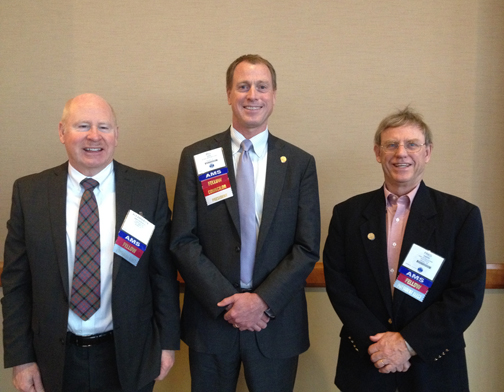At the Annual Meeting in Phoenix, AMS premiered a new series of TED-styled conversations called “23|5 Talks,” which brought together some of the leading voices in the weather, water, and climate community.
The first 23|5 Talk was given by Sheldon Drobot, who works at UCAR on providing up-to-the-minute weather information for drivers. On Monday, Sheldon spoke about the dangers of driving in bad conditions and solutions to these problems.
See the AMS’s YouTube page for other 23|5 Talks with Marshall Shepherd, Kristen Averyt, and David Kenny. Thanks for joining us in Phoenix and drive safely!
AMS2015
Book It! ASLI Announces 2014 Winners
Atmospheric Science Librarians International (ASLI) today celebrated their 10th year of honoring the best books in the fields of meteorology, climatology, and the atmospheric sciences at the ASLI Choice Book Award Ceremony at the Annual Meeting. Each year, ASLI chooses the best books based on nine criteria: uniqueness, comprehensiveness, usefulness, quality, authoritativeness, organization, illustrations/diagrams, competition, and references. 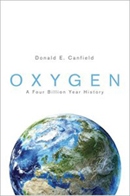
The winner of the main award for 2014 was Oxygen: A Four Billion Year History, by Donald E. Canfield, published by Princeton University Press, which ASLI praised for being “a well-documented, accessible, and interesting history of this vital substance.” There were also awards given in two other categories. The winner of the History award was The History of Global Climate Governance, by Joyeeta Gupta, published by Cambridge University Press, for “bringing together a history and summary that readers are likely to reference often.” 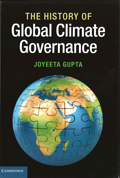 The top award in the Popular category went to Storm Surge: Hurricane Sandy, Our Changing Climate, and Extreme Weather of the Past and Future, by Adam Sobel, published by HarperWave, which was recognized by ASLI for “providing its readers with a detailed, clear understanding of the meteorological basis for Hurricane Sandy and the importance of our response to it.”
The top award in the Popular category went to Storm Surge: Hurricane Sandy, Our Changing Climate, and Extreme Weather of the Past and Future, by Adam Sobel, published by HarperWave, which was recognized by ASLI for “providing its readers with a detailed, clear understanding of the meteorological basis for Hurricane Sandy and the importance of our response to it.”
In the Science category, Honorable Mention awards were given to Dendroclimatic Studies: Tree Growth and Climate Change in Northern Forests, by Rosanne D’Arrigo, Nicole Davi, Gordon Jacoby, Rob Wilson, and Greg Wiles, and published by the American Geophysical Union, for “a clear summary of research from a renowned institution on this important topic”; and Air Quality Management: Canadian Perspectives on a Global Issue, edited by Eric Taylor and Ann McMillan, published by Springer Netherlands, for “bringing together expert views on many aspects of this topic from a Canadian perspective.” 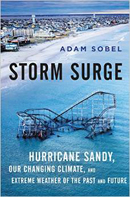 Honorable Mention in the History category was given to Tambora: The Eruption that Changed the World, by Gillen D’Arcy Wood, published by Princeton University Press, which ASLI described as “a book that makes this extreme event newly accessible through connecting literature, social history, and science.” And Honorable Mention in the Popular category was awarded to a title from AMS Books: Partly to Mostly Funny: The Ultimate Weather Joke Book, edited by Jon Malay with jokes from Norm Dvoskin, was praised by ASLI for being “a handy compilation of lighthearted humor about the weather and its place in our lives.”
Honorable Mention in the History category was given to Tambora: The Eruption that Changed the World, by Gillen D’Arcy Wood, published by Princeton University Press, which ASLI described as “a book that makes this extreme event newly accessible through connecting literature, social history, and science.” And Honorable Mention in the Popular category was awarded to a title from AMS Books: Partly to Mostly Funny: The Ultimate Weather Joke Book, edited by Jon Malay with jokes from Norm Dvoskin, was praised by ASLI for being “a handy compilation of lighthearted humor about the weather and its place in our lives.”
After you’re finished reading the best of 2014, be sure to let ASLI know what you liked in 2015 by sending them nominations for next year’s awards; you can get more information here.
The Buzz Continues at #AMS2015!
For the 2015 AMS Annual Meeting, we’ve brought back The Buzz @ AMS, our “on the street” interviews with attendees. If you haven’t been to an AMS Annual Meeting before, these videos will help give you a perspective of what’s happening in the convention center. And if you’re here with us in Phoenix, maybe you’ll be the next one we talk to.
We hope you’ll check out our YouTube channel for the latest buzz from the meeting.
They Said It in Verse…Meteorology Implied
Louis Uccellini, director of NOAA’s National Weather Service, now says he doesn’t even remember exactly why he went to Bob Glahn’s office to talk that day. It was to continue a debate on some point or another,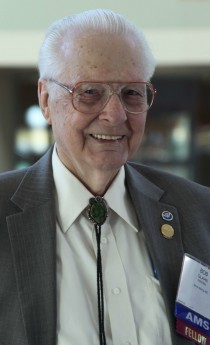
Uccellini told the audience in a keynote for the Symposium honoring Glahn this morning.
“But I do remember what happened when I walked into the office,” Uccellini said. “I actually walked in and he wasn’t there, and I saw he had this big anthology of Robert Frost. I’ve read two biographies on Frost, I have my own books and all. I just started paging through it.”
An inevitable connection was forged. For the next half hour the two meteorologists talked not about their views on modeling but about the art of a mutually revered poet. Glahn told Uccellini his favorite Frost poem was “Stopping by Woods on a Snowy Evening.” Uccellini says
Bob assumed that because ‘Snowy’ was in the title that it was my favorite too. I disappointed him, but it’s really a fantastic poem, obviously, from a poetry perspective. The structure of it where the end of the third line in one stanza sets the rhythm and rhyming of the next stanza. Frost said he wrote this thing in about an hour. Came off the farm and this thing had been going through his head. Just blasted it down. You think it’s just about a nice walk in the woods or a ride in the woods and then you get to the last stanza and it just hits you with one of these dark aspects. This really is the basis of his poems.
A friend of mine sent me a book with all of Frost’s letters to his children, and I came across this phrase. I actually mentioned this to Bob once, about this particular phrase: ‘All poetry has said something and implied the rest. Well, then why have it say anything? Why not have it imply everything?’
This really struck for me because, as a scientist, this is almost a crime. You’ve got to have everything exact, what you mean—and this is just the opposite. For me poetry is a release valve and I was wondering why Frost’s poems captured Bob’s attention. I think it was for the same reason.
It was a powerful statement of the creative exactitude with which Glahn reshaped the way meteorologists forecast weather by combining numerical prediction with statistics and probabilities, using mathematics to express a human dimension to meteorological products.
And Uccellini’s favorite Robert Frost poem? “Looking for a Sunset Bird in Winter.”
Plenty of snow, of course.
[Above: photo of Bob Glahn by Sean Potter/NOAA/NWS]
A Time for Geeks
Four episodes of The Weather Channel program “Weather Geeks” were taped in the Exhibit Hall yesterday, bringing large, enthusiastic crowds that made the Annual Meeting feel more like an ESPN College GameDay event. Some were even inspired to write haikus. Here’s a flavor of the action:
The Doctor is in! 15mins away… #AMS2015 pic.twitter.com/GWohS3lPCa
— WXGeeksTWC (@WXGeeksTWC) January 6, 2015
Its not quite College GameDay but handwritten signs made for the broadcast. I dont see any mascot heads either. #AMS2015
— Marcus Smith (@MRSmithSEWX) January 6, 2015
LOOK at the live crowd we have for @WXGeeksTWC! This is awesome. #AMS2015 pic.twitter.com/NDMWjzBkco
— Kathryn Prociv (@KathrynProciv) January 6, 2015
Watching @WXGeeksTWC taping at #AMS2015 with @kimklockow and @CommDocPA pic.twitter.com/NVMNwnpjlx
— Rick Smith (@ounwcm) January 6, 2015
@weatherchannel @wxgeekstwc haiku: Marshall Shepherd is the man. Giving the weather weenies voice on TV. It is amazing out there. #AMS2015
— Minh Phan (@WXMinh) January 6, 2015
@weatherchannel @WXGeeksTWC Send out the warning. Storms are on the horizon. The geeks are coming… #AMS2015 #WxHaiku
— Matthew Brown (@Rhapsodyinbrown) January 6, 2015
@hollylowry & I are so excited to be at a @WXGeeksTWC filming here at #AMS2015 ! Can't wait to watch in a few weeks! pic.twitter.com/KCFn9T0HTE
— Faith Eherts (@WxFaith) January 6, 2015
It's showtime! @WXGeeksTWC @DrShepherd2013 @CommDocPA #AMS2015 pic.twitter.com/oeKqyqqvht
— Amberrr (@Ambermometer) January 6, 2015
Geek scale turned up to 11 at the taping of WeatherGeeks. #AMS2015
— Chris Hattings (@wxgeekbeavis) January 6, 2015
.@KathrynProciv and I backstage for @WXGeeksTWC tapings at #AMS2015!! pic.twitter.com/YaIEuuNkbA
— Chrissy Warrilow (@AtlantaWxGirl) January 6, 2015
YES…THEY BROUGHT SIGNS RT @davidwkenny: #itsamazingotthere at #AMS2015 on @WXGeeksTWC @weatherchannel pic.twitter.com/ywh06JSBbr
— Sean Breslin (@Sean_Breslin) January 6, 2015
El presidente times two… Weather Geeks is taping now come check it out . #AMS2015 #wxgeeks pic.twitter.com/6nJywAYPw1
— Mike Chesterfield (@mchesterfield26) January 6, 2015
The people who made #AMS2015 @WXGeeksTWC possible and thank all of you for coming out. It's your show pic.twitter.com/jpuIW6nQGf
— Marshall Shepherd (@DrShepherd2013) January 7, 2015
A Tale of Two Studies: Varied Perspectives at the AMS Meeting
by Maggie Christopher, Valparaiso University
On Sunday students presented nearly 200 posters of their research in grad school and summer internships. With so many topics covered, the session covered a variety of perspectives—often multiple perspectives on similar questions.
For example, two students from different universities did individual studies of the socioeconomic factors in fatalities due to tornadoes. But while Shadya Sanders from Howard University compared two case studies, Omar Gates, from the University of Michigan, set one tornado case in a climatological perspective.
Sanders compared the Joplin, Missouri, and Tuscaloosa, Alabama, tornadoes in 2011. Sanders looked at the differences in death rates for race, age, gender, and housing structures in each storm. She found, for example, a high rate of death amongst women, which she said is unusual compared to other data she looked at. Women generally will take the suggested protective action when warnings are issued.
Sanders also noticed that in Tuscaloosa people aged 21-30 died at a higher rate, probably because the University of Alabama is located in the city of Tuscaloosa. By contrast, in Joplin, more retail business were located in the path of the storm, rather than houses.
Similarly, Gates studied the effect of tornado outbreaks as climate changes. He hoped to show the risk of tornadoes striking cities. He focused his research on Oklahoma, and specifically the May 3, 1999 tornado in Moore. Gates used reanalysis data with the North American Regional Reanalysis (NARR), and also utilized 2010 Census Data, which included demographic information such as gender, race, age, and housing units.
Using ARCgis, Gates put together risk assessment maps for vorticity, moist static energy, and wind shear. These maps were then put together, along with the actual storm track, to locate the highest risk of tornadoes for that day.
Even with different approaches, Shayda and Gates had similar goals for their work. Shayda held focus groups in both cities to see what kinds of warnings citizens would find most helpful. She wants to insure that warnings get out to everyone, and she hopes to continue her research throughout the rest of the United States. Similarly, Gates hopes that continuing to look at the socioeconomic effects of tornadoes will lead to watches, outlooks, and warnings that are easier for people to decipher, saving lives.
Presidential Forum Drops the Puck on #AMS2015
Speakers at the Presidential Forum looked back, looked ahead, quoted Yogi Berra and Wayne Gretzky, and made attendees think about how far meteorology has come…and how far it could go in the future. Here are a few Twitter highlights:
#AMS2015, several thousand #weather and #climate professionals/stakeholders, presidential forum….let's go pic.twitter.com/FpscvsX9pn
— Marshall Shepherd (@DrShepherd2013) January 5, 2015
Inspiring to hear and see @kimklockow and @AstroKDS in the opening session of #AMS2015 as a female meteorology student.
— Kate-Lynn Walsh (@klwalshwx) January 5, 2015
Dr. Sullivan talking about technologies 25 years ago….1990….puts things in perspective as to how far tech has come so far #AMS2015
— Jared Rennie (@jjrennie) January 5, 2015
Dr. Sullivan quotes the great Yogi Berra – "Predictions are hard to make;especially about the future." #AMS2015
— Chris Hattings (@wxgeekbeavis) January 5, 2015
What will meteorology be like in 2040? We have a "living ensemble" of experts here to help predict it! #AMS2015
— Matthew Strauser (@pitpenguins87) January 5, 2015
Kathryn Sullivan NOAA administrator on 2040: personalized weather, rise of drones, biomimicry, sensor networks, science gaps, HPC #AMS2015
— Michael White (@MWClimateSci) January 5, 2015
Dr. Sullivan: We have to keep the human dimensions of technological change in focus. #AMS2015 #NOAA
— Keli Pirtle (@keliwx) January 5, 2015
as weather extremes increase, so will demand for weather information–water, food, energy nexus will be critical societal issue #AMS2015
— explomary (@explomary) January 5, 2015
.@noaa Administrator Kathy Sullivan quotes Gretzky in her thoughts about 2040 – we need to skate to where the puck is going to be #AMS2015
— Kathie Dello (@KathieDello) January 5, 2015
Sullivan: Customization and hyperlocalization are the future. #AMS2015
— Jason Elliott (@jsaysitall) January 5, 2015
Dr. Sullivan – find your learning sweet spot – Be just scared enough of new opportunities and take the risk #ams2015
— Andrea Melvin (@adm_wxed) January 5, 2015
"An absolute passion and fascination for the atmosphere and a drive to keep people safe" – @BernadetteWoods on why mets become mets #AMS2015
— Andrea Thompson (@AndreaTWeather) January 5, 2015
"Even if we bust the forecast, they come right back to us" – @BernadetteWoods on how public looks to mets for wx and climate info #AMS2015
— Andrea Thompson (@AndreaTWeather) January 5, 2015
Great reminder from panelist Curtis Walker. High impact weather events will still be with us, even if we're more tech advanced #AMS2015
— Alek Krautmann (@AlekKrautmann) January 5, 2015
In 2040, question raised: how will we tailor our enterprise to be the most useful to our end-users? Answer: you have to ask them. #AMS2015
— Deanna Hence (@deahence) January 5, 2015
One member of our living ensemble, @BernadetteWoods , predicts a 100% chance that meteorologists will still be needed in 2040. #AMS2015
— Matthew Strauser (@pitpenguins87) January 5, 2015
The Communication Continues on YouTube
New videos from the Annual Meeting in Phoenix continue to be posted on the AMS YouTube channel. So far you’ll find interviews with new AMS Fellow Jack Williams, on weather in the media; AMS Associate Executive Director William Hooke, on the state of the weather, water, and climate community; and UCAR President Tom Bogdan, on space weather science developments at the meeting this week.
More interviews with you and your colleagues, from poster sessions to hallway conversations, will be appearing on the channel throughout the meeting, so keep talking!
A Question for the Experts
There have been many thoughtful questions raised throughout this weekend’s AMS Student Conference, but one question posed at the communications breakout session on Saturday proved particularly challenging for the panelists. A student asked, “How do you educate the public that doesn’t have access to television or social media? How do we educate the homeless about severe weather events?”
Here were the responses from the panelists:
Marshall Shepherd, Univ. of Georgia: I think you’re hitting on a key question. The homeless question…that’s tough. These are the people who aren’t watching, necessarily. That really involves grassroots efforts. TV stations can be involved in galvanizing and organizing. So, for example, I teach a class at the University of Georgia on urban climate, and one of the projects I ask students to do is look at tornado sirens in the Athens/Clark County region. One of the things we found was that the way the tornado sirens were distributed, there were significant parts of the population—particularly those who were underserved or lower income—who didn’t even have sirens where they lived.
So I think there’s a whole notion of increased social sciences and environmental justice and all types of issues that we all have to be aware of and address. I don’t know the answer to that question you asked, and I think there’s an opportunity.
Ginger Zee, ABC News: I’ve done four stories on that same thing of the sirens, because there’s no federal law, state law, no county law in any state that says there has to be one. I grew up in Michigan and we had them in every single town. It’s amazing to me that there are places that don’t have them, especially in places that really need them but don’t. Requiring outdoor warning systems—I don’t know if that’s going to happen; it’s not going to be funded.
I think the community outreach part is probably your best bet. You guys remember in Virginia this year, there was a camp with a bunch of kids outdoors and a long line of storms on the ground for three hours. It’s amazing to me that they still didn’t have warning. That can’t go on. There was one kid who died. That shouldn’t have happened, because once they got indoors they were safe inside. If that was a fire and they didn’t have a smoke alarms, we would not be having the same discussion. They would have been sued like crazy.
Weather has grown…our ability to forecast has grown and now the whole policy part of it has to catch up. I think that will take time.
Keli Pirtle, NOAA: The National Weather Service works with local emergency managers to help prepare communities through the Storm Ready program. I would hope that a shelter, like a homeless shelter, would have a NOAA Weather Radio. That’s a hope more than a reality, I’m afraid. We can encourage people—churches, nursing homes, schools—to have multiple ways to receive information, to have a plan. A homeless person on the street, they’re in touch with others. I would hope the network on the street would get them the information, but it’s certainly an area where we desperately need to improve.
Jorge Torres, KOB-TV: And I agree with that. At our station, we’re partners with the Red Cross, and with the Roadrunner Food Bank of New Mexico, which helps feed the hungry because New Mexico is, I believe, the number one state in the country for childhood hunger. So we do have outreach programs with the lower-income communities. But that’s not in the form of weather [information] mostly, it’s in the form of talking to them. I do think you bring up a good point that those who don’t watch us, can’t watch us. They’re the ones who deal with the elements much more—the homeless especially—than the rest of us because we have a roof over our head and they don’t.
A Presidential Presence in Phoenix
At the Annual Meeting each year, past, current, and future AMS presidents come together. In Phoenix today, incoming AMS president Alexander “Sandy” MacDonald takes the reins from outgoing president Bill Gail.
“I hope to make the best use of my years of experience to bring the government, commercial, and academic communities together,” MacDonald comments. “I feel that my theme for next year’s meeting, ‘Earth System Science in Service to Society,’ weaves the many parts of AMS into a common core.”
For MacDonald, that experience is considerable: namely, 43 years at NOAA, with a diverse list of contributions to the science of weather and climate. One of them—his Science On a Sphere® —will be showcased at the kickoff of the meeting in Phoenix. The multimedia system displays full-color animated images of satellite, geophysical, and astronomical data on a sphere. It’s in more than 110 museums and science centers around the world and is now educating millions of people a year about many aspects of our planet.
MacDonald notes that “AMS is unique in bringing together the effort of understanding our Earth and the people who use that information to make life better.” (MacDonald’s career and plans as president are profiled in the upcoming January issue of BAMS.)
Following MacDonald in the leadership queue is Frederick Carr, who serves as AMS President Elect this year. Similarly to MacDonald, Carr’s plans as AMS president in 2016 include facilitating synergies and partnerships among all components of the atmospheric science community.
“I am honored and excited to be elected AMS President and look forward to helping the AMS provide leadership and support to the academic, public, and private sector members of the Society,” Carr says. “My current thinking is that the theme of the 2017 Annual Meeting will be ‘Observations Lead the Way,’ meaning that in all aspects of our related disciplines, from improving forecasts to making data-based policy decisions, obtaining and making best use of increased observational capabilities will best move our science forward.”
Fred has spent the past 37 years as a professor of meteorology at the University of Oklahoma, and served as the director of the School of Meteorology for 14 years (1996-2010) as the program doubled in size and moved into the National Weather Center. His expertise straddles both observational meteorology and numerical weather prediction. He takes pride in both having made significant improvements to NCEP’s numerical models in the 1980s and ‘90s and in the professional success of his students. He has served the AMS in many capacities, including as editor or associate editor of three AMS journals and as councilor (2001-04). He currently serves as cochair of the UCAR Community Advisory Committee for the National Centers for Environmental Prediction and on the UCAR Board of Trustees.
“I welcome all members of the AMS, from students to honorary members, to contact me if they have any suggestions for how the AMS can better serve them as we move forward to the 100th anniversary of AMS,” Carr notes. MacDonald echoes that sentiment, encouraging member input at the upcoming Annual Meeting as well as throughout the year as the Society’s Centennial approaches.
